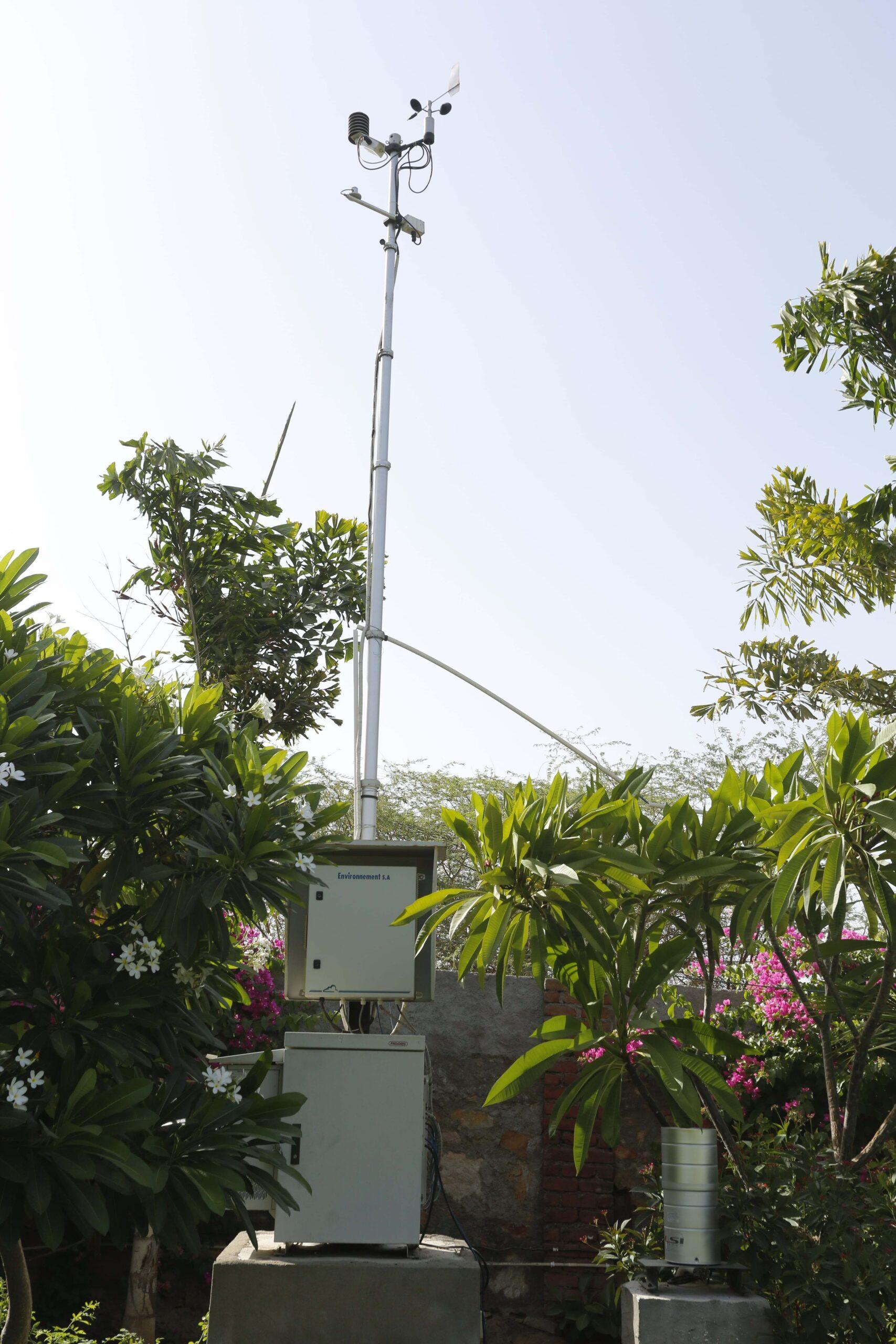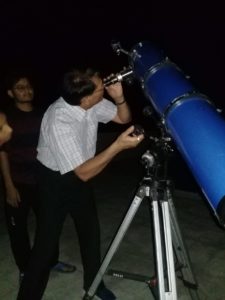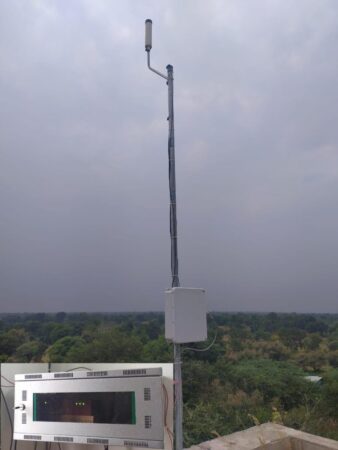Our Projects

SAFAR (System of Air Quality and Weather Forecasting And Research)
Ministry of Earth Science, Govt. of India. Indian Institute of Tropical Meteorology,
Pune RNT Group of Colleges, kapasan, Chittorgarh
SAFAR is basically a Automatic Weather Station (AWS) installed in the campus of RNT, College for Ambient Air Quality Monitoring (AAQM) with the weather parameters measurements like Solar flux, Dew points, Humidity, Pressure, Temperature, Rain gauge, Wind speed and direction. SAFAR project is under MoU with IITM, Pune underfunding agencies of Ministry of Earth Science, New Delhi and its data is shared by Scientists of PRL, IITM. AAQM is being done regularly using ingenious instruments costing around 1.3 crores and results are displayed on digital screen for the general awareness on the gate of RNT.P.G. College. Abundances of NOx, SOx, CO, CO2 and non methane compounds present in ambient air are measured for specific modeling of eco-environment. Beside this we monitor Ozone gas precursors day and night to model the atmospheric chemistry for orographic climate of southern Rajasthan specifically in the Aravali region of state Rajasthan. We also estimate and record the amount of particulates (Organic and inorganic carbon particulates of sizes 2.5 micron and 10 microns) present in ambient air due to anthropogenic activities. These aerosols very much govern the climatic conditions for diurnal and seasonal variability. They are also responsible for the abnormal precipitations and temperature variations leading to conditions like floods and draughts in the regions. Beside this we also correlated the data of solar activity in this project with the rain trends in India and found how solar flux governs the variability in rain. The finding revealed the role of anthropogenic and solar activity in the situations of drought and flood on the earth. SAFAR data in the next study of rain on ocean alone would further help to understand the extrinsic contribution of solar activity on irregularity in rain trends. These results play key role in understanding the climatic behavioral trends which may help in growth of agriculture and immediate administrating the natural calamities managements. The data of aerosols and atmospheric parameters are very useful in deciding the conditions of the atmospheres and climate around us. Data are significant for the theoretical modeling to understand the cloud aerosol interaction and precipitation enhancement. We have evolved alone under this project 11 research papers in the last three years which are published in reputed and referred international journals and two students received PhDs.
 IUCCA
IUCCA
(Inter University Centre of Astronomy and Astrophysics) project.
IUCAA, Pune
RNT GROUP OF COLLEGES
This project is for research in Astronomy and Astrophysics with high computational capability data analysis of Celestial objects like Black hole, X-ray Binary Neutron stars, Gravitational waves and Galaxies. IUCAA project is under MoU with IUCAA, Pune, and it has been funded with high computational capability computers and ingenious 6” telescope instruments costing around 0.11 crores by University Grant Commission, New Delhi. We could set several experiments including the field of Solar Physics and Stellar Physics for compact objects such as X-rays Binaries, Neutron stars and black holes. Under this project students and teachers have been engaged in doing analysis for the Archival data of Rossi X-ray timing explorer (RXTE), Hinode, and Beppo Sax and are at hand-on training with Linux operating system uploaded on their individual computers available in Astronomy and Astrophysics Laboratory. In every academic session, observational experiments based upon G.M. counter, optical 6” telescope are designed by students under the supervision of experts and professors. This activity of our RNT College has enhanced the input flux of skilled and trained students as researchers for various national Astrophysics laboratories where x-ray spectroscopy studies are being done such as PRL, TIFR, IUCAA, RRI, and IIA etc of our nation. Various minor projects are being given to teachers and students at free access to take over in the field of Solar Physics, and meteorology, in the collaboration with the scientists of IUCAA, IITM resource centers, and the existing world-famous Udaipur Solar Observatory (USO) in Udaipur city.
RNT College, Kapasan is organizing the ISRO exhibition every year in the Udaipur and Chittorgarh district to learn more about what ISRO-India is doing progress in the field of space science. The students take optical observations of the Sun using 25 cm telescope with various filters like, H-alpha, and G-band to study the solar activity over the photosphere and chromospheres. Basic space based experiments are also demonstrated by the team of scientists to attract students and teachers towards the astronomy and astrophysics. These activities of M.Sc. student and teachers of our RNT College directly give rise exposure to recent trends investigated in the solar physics, meteorology and space science. Last year one student was selected in BARC, Mumbai, and we look forward more students to crack this kind of opportunity in near future and to have selection in PRL, IITM, and TIFR on the basis of these activities of teaching and making of working research models.

LLN
(Lightning Location and Networking) project.
IITM, Pune
RNT GROUP OF COLLEGES, KAPASAN
The major objective of this project is to collect the quality data for lightning measured within 1000km radius area for the purpose of electrical energy harnessing. LLN project is under MoU with IITM, Pune, and is underfunding of ingenious instruments costing around 0.30 crores by Ministry of Earth Science, New Delhi. A physical phenomenon involved in working of lightning rod with appropriate grounding and mechanism of lightning are well understood today. The total source of electrical energy 1.45 x 1024 Joule/year available in clouds in the form of lightning might fulfill the increasing demand of our entire world as expected 3.0 x 1020 Joule/year by the coming year of 2040 as compared to currently total electric consumption 2.0 x 1020 joule/year in the year 2020. Today what we need is to develop an appropriate technology in order to harness lightning electrical energy from the clouds is the aim of this project.
The major problem of lightning power capturing at its first look is how to store the huge amount of electricity for later use and second it is spontaneously random and sporadic in nature. The main limiting factor is the lacking of indigenous technology connected to Utility Scale Battery, capacitors at large scale for grid use. Moreover harnessing of power would be practically possible in that area where lightning strike is very frequent, almost in the season of monsoon it is very common all over India and over the world. Their abundance of occurrence on coastal area and on land in pre-monsoon and in monsoon season is predominant, it is very common during the heat wave belt which in India starts from Rajasthan desert and ends up in the Maharashtra and Madhya Pradesh. Nevertheless the detail study of Lightning Location Network data recorded over the several years would be significant and would play an important role to identify the appropriate location for installing the lightning harnessing power plant. . LLN measurements showed that frequency of occurrence of Lighting was found to be on an average 40 -50 times in a second over the entire earth globe and total expected lightning of about 1.5 billion per year. Thus it becomes 3.22 x 1020 Joule/ year and is sufficient to fulfill the demand of electric consumption of entire world in future.
The solution seems possible out of indigenous technology maneuvered by electrical engineers to make harnessing power plant working at large scale. However implementation of electrical engineering and layout designing both will be of great help in order to capture the massive amount of electricity generated in bolt and to transfer to large storage device for later use. The lightning harnessing power plant after quality designing and engineering would become an ultimate natural resource of our electricity need and electric power for later use. For immediate distribution of power, we need to convert into Alternating Current Power (ACP) for the sake of safety and would be stepped down into smaller useful alternating voltages using multi step-down transformers network will be able to enlighten numbers of villagers, cities, farmers for agriculture use and to the number of industries for their growth and production. We have analyzed the problem based upon LLN data and found that per km2 area the rate of electric power practically available in lightning is 6.84 x 103 Watt /km2/second. Although computed value is based upon the assumption that at large scale even in rainy season at a time, it does not rain uniformly all over India or anywhere in the world. It is sporadic and in some part it rains and in some other part it does not. We estimated that 200 proposed lightning plants are required to be constructed in India that is 100 on sea shore site and 100 near lakes towards land sites to meet out the demand of electricity of 369.3 x 1012 Watt/year. Similarly the entire world needs 4.8 x 1016 Watt/year, therefore globally we require total 20,000 lightning capturing power plants to be cropped according to their demands in North and South America, , Canada, Europe, Russia, China, Japan, North and South Korea, Philippines, Indonesia, Australia, New Zealand, India, Pakistan, Afghanistan, Iran, Egypt, Africa, South Africa, and Middle East countries.
The following are proposed activities to be undertaken by RNT College, Kapasan in near future:
- Research on Gravitational-wave would be started in collaboration with IUCAA, and Pune scientists because LiGO-India facilities would come soon to India.
- X-rays binaries harboring neutron star and black hole candidates studies would be continued in collaboration with IUCAA scientists analyzing the archival data.
- Solar magnetic fine structures investigations would be continued in the collaboration with the USO, and Udaipur scientists.
- Training for the Astronomical data and observation at IGO-TAC IUCAA after submitting the proposals.
- Data–Center for analysis and training of multiwavelength observations taken for Compact Objects, Galaxies, and Stars by ASTROSAT.
- South Africa large telescope SALT facilities share an optical telescope of 2 meters with the IUCAA scientists.
- LIGO-India facilities would be used when it would come to India with the big efforts of IUCAA, Pune
- Small trainings with help of 6” telescope coupled with CCD camera which would be given to local people and students who are opting for Astronomy and Astrophysics as a special course at the M.Sc level in RNT College.
- Popularization of Astronomy and Astrophysics through seeing programs at night for the Astronomical events and by organizing the workshops, seminars, and national and international conferences at RNT College.
- Training programs for teachers and students at the school level would be organized the promotion of their interest in Astronomy and Astrophysics by arranging popular public lectures by eminent scientists and demonstrating of the physical phenomena of Astronomy and Astrophysics by working models.
- Joint – projects with the Agriculture Faculty of RNT, College would be submitted to DST on the recent research topics of meteorology, in poultry to improve the quality of eggs of birds for a cheap feed of barley and other unusable slurry materials, Nilgai husbandry for better hospitality, and their hybridization with other pet animals such as oxen and horses in order to develop new breed for evolution studies.
- New patents application on Lightning electrical energy harnessing would be processed.
- Conservation of solar panel energy project would be submitted for optimal use of generated electricity in RNT college.
- Ground-based observations of secondary cosmic rays and solar radiations approaching after interaction with the atmospheric gases using a scintillation detector in the energy range of few keV to several MeV. Secondary cosmic rays contain fluorescent atmospheric X-rays, and gamma rays accompanied by many other particles like muons electrons, positrons, and fragmented nuclei from the atmospheric gases. The detection of these atmospheric X-rays and gamma rays helps in identifying the intruded gases polluted in the lower part of the troposphere through anthropogenic sources and the extraterrestrial sources of the meteoritic showers, comets and primary cosmic rays carrying space elemental charged particles. These kinds of studies have become a unique tool nowadays in finding the percentage abundance of the pollutants in the lower atmosphere.

